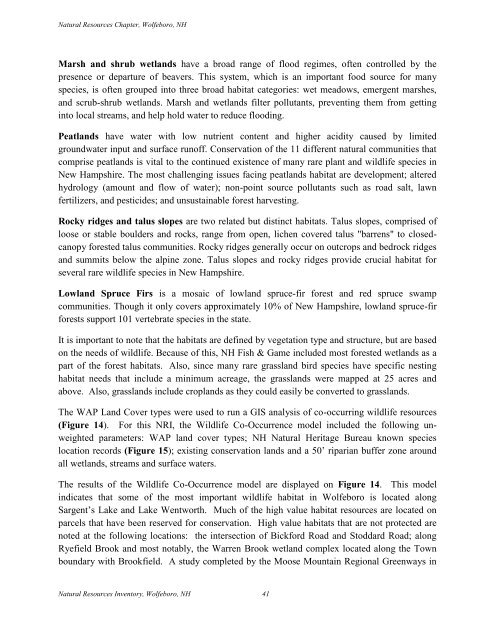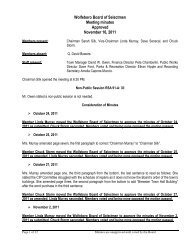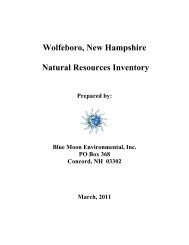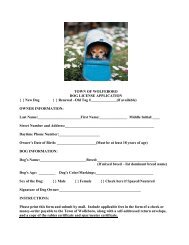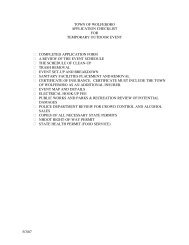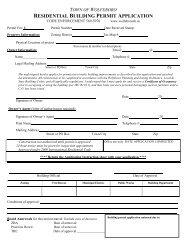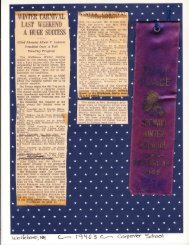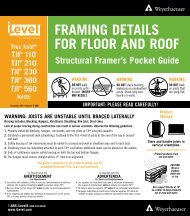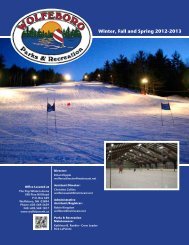Natural Resources Chapter of the Master Plan - Town of Wolfeboro
Natural Resources Chapter of the Master Plan - Town of Wolfeboro
Natural Resources Chapter of the Master Plan - Town of Wolfeboro
Create successful ePaper yourself
Turn your PDF publications into a flip-book with our unique Google optimized e-Paper software.
<strong>Natural</strong> <strong>Resources</strong> <strong>Chapter</strong>, <strong>Wolfeboro</strong>, NH<br />
Marsh and shrub wetlands have a broad range <strong>of</strong> flood regimes, <strong>of</strong>ten controlled by <strong>the</strong><br />
presence or departure <strong>of</strong> beavers. This system, which is an important food source for many<br />
species, is <strong>of</strong>ten grouped into three broad habitat categories: wet meadows, emergent marshes,<br />
and scrub-shrub wetlands. Marsh and wetlands filter pollutants, preventing <strong>the</strong>m from getting<br />
into local streams, and help hold water to reduce flooding.<br />
Peatlands have water with low nutrient content and higher acidity caused by limited<br />
groundwater input and surface run<strong>of</strong>f. Conservation <strong>of</strong> <strong>the</strong> 11 different natural communities that<br />
comprise peatlands is vital to <strong>the</strong> continued existence <strong>of</strong> many rare plant and wildlife species in<br />
New Hampshire. The most challenging issues facing peatlands habitat are development; altered<br />
hydrology (amount and flow <strong>of</strong> water); non-point source pollutants such as road salt, lawn<br />
fertilizers, and pesticides; and unsustainable forest harvesting.<br />
Rocky ridges and talus slopes are two related but distinct habitats. Talus slopes, comprised <strong>of</strong><br />
loose or stable boulders and rocks, range from open, lichen covered talus "barrens" to closedcanopy<br />
forested talus communities. Rocky ridges generally occur on outcrops and bedrock ridges<br />
and summits below <strong>the</strong> alpine zone. Talus slopes and rocky ridges provide crucial habitat for<br />
several rare wildlife species in New Hampshire.<br />
Lowland Spruce Firs is a mosaic <strong>of</strong> lowland spruce-fir forest and red spruce swamp<br />
communities. Though it only covers approximately 10% <strong>of</strong> New Hampshire, lowland spruce-fir<br />
forests support 101 vertebrate species in <strong>the</strong> state.<br />
It is important to note that <strong>the</strong> habitats are defined by vegetation type and structure, but are based<br />
on <strong>the</strong> needs <strong>of</strong> wildlife. Because <strong>of</strong> this, NH Fish & Game included most forested wetlands as a<br />
part <strong>of</strong> <strong>the</strong> forest habitats. Also, since many rare grassland bird species have specific nesting<br />
habitat needs that include a minimum acreage, <strong>the</strong> grasslands were mapped at 25 acres and<br />
above. Also, grasslands include croplands as <strong>the</strong>y could easily be converted to grasslands.<br />
The WAP Land Cover types were used to run a GIS analysis <strong>of</strong> co-occurring wildlife resources<br />
(Figure 14). For this NRI, <strong>the</strong> Wildlife Co-Occurrence model included <strong>the</strong> following unweighted<br />
parameters: WAP land cover types; NH <strong>Natural</strong> Heritage Bureau known species<br />
location records (Figure 15); existing conservation lands and a 50‟ riparian buffer zone around<br />
all wetlands, streams and surface waters.<br />
The results <strong>of</strong> <strong>the</strong> Wildlife Co-Occurrence model are displayed on Figure 14. This model<br />
indicates that some <strong>of</strong> <strong>the</strong> most important wildlife habitat in <strong>Wolfeboro</strong> is located along<br />
Sargent‟s Lake and Lake Wentworth. Much <strong>of</strong> <strong>the</strong> high value habitat resources are located on<br />
parcels that have been reserved for conservation. High value habitats that are not protected are<br />
noted at <strong>the</strong> following locations: <strong>the</strong> intersection <strong>of</strong> Bickford Road and Stoddard Road; along<br />
Ryefield Brook and most notably, <strong>the</strong> Warren Brook wetland complex located along <strong>the</strong> <strong>Town</strong><br />
boundary with Brookfield. A study completed by <strong>the</strong> Moose Mountain Regional Greenways in<br />
<strong>Natural</strong> <strong>Resources</strong> Inventory, <strong>Wolfeboro</strong>, NH 41


